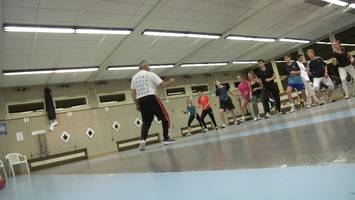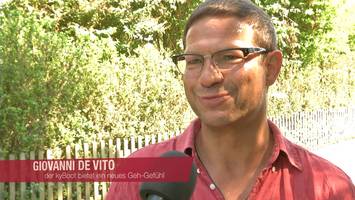Hip osteoarthritis/coxarthrosis
Definition
Hip osteoarthritis is a degenerative disorder of the hip joint, especially with advanced age, which is caused by wear of the cartilage surface on the hip joint socket and femoral head. It is the most common form of osteoarthritis in humans.
Osteoarthritis is a degenerative joint disorder, caused primarily by discrepancies between the load and load capacity of various parts of the joints and tissue.
Load-dependent pain directly in the hip joint is characteristic of the disorder. This pain radiates to the groin. However, pain frequently originates in the area of the lumbar spine and sacroiliac joint as well.
Causes
Causes of osteoarthritis in the hip may include various (previous) diseases or (past) injuries involving the hip joint. However, no precise cause can be determined in about one quarter of all cases.
Osteoarthritis can be caused by excessive weight and excessive strain, such as occurs during extreme sports or when performing heavy physical labour. Causes also include changes in the cartilage metabolism with advanced age, metabolic disturbances, congenital malformations and acquired joint deformities, for example due to inflammatory joint diseases or after an injury.
Years of improper strain on the hip joint while walking is another possible cause (see Fig. 1 and 2) The greater the impact while walking and the less precise the movement, the faster the cartilage will wear. The main cause of improper strain on the hip joints is the long periods of time we in industrialised western nations spend sitting every day, something that nature did not intend. Sitting for hours leads to the progressive shortening of the hip flexors. As a result, the person is no longer able to achieve a physiologically correct gait with the upper body upright. This in turn leads to excessive strain on the neck and back musculature, incorrect knee and hip position and therefore increased cartilage wear.
Definition
Der ganze Körper ist umhüllt von Faszien, welche miteinander verbunden sind. Faszien verlaufen in sogenannten Zuglinien oft von Fuss bis Kopf. Die Hüfte liegt mitten in diesen Linien. Sind in einem oder mehreren Bereichen dieser Linien Verklebungen und/oder Verkürzungen vorhanden, so herrscht unnatürlich viel Zug in der ganzen Linie und entsprechend auch auf die Hüfte. Dadurch wird auf das Hüftgelenk übermässig viel Druck ausgeübt. Somit reiben die Gelenkflächen stärker aneinander als vorgesehen und als Folge werden Degenerationen im Gelenk, sprich Arthrose, gefördert oder verschlimmert. Abgesehen von Verletzungen als Grundlage entstehen Verklebungen und Verkürzungen durch das unnatürliche Gehen und Stehen auf den harten, flachen Alltagsböden, sowie durch langes Sitzen.
Long-term consequences – trapped in a vicious circle
Conventional therapy
The kybun mat and kybun shoe are ideal for bringing more movement to everyday life and escaping the downward spiral of osteoarthritis – all without spending any additional time. Acute pain is relieved quickly and longer walking distances are possible again since strain on the hip joints is reduced.
The soft, elastic foam material acts as a ‘crumple zone’, effectively dampening impact on the joints during running and walking.
Exercise becomes more comfortable again, and hip complaints are reduced after just a few minutes in most cases. Those who like to exercise frequently find it much easier to shed extra pounds, which in turn reduces strain on the joints. Nearly all customers affected by osteoarthritis report a reduction in pain since they started wearing the kybun shoe.
It’s not only the cushioning effect that helps alleviate pain. When standing the soft, elastic supporting underlay, one automatically keeps moving very slightly. When standing and walking on soft, elastic materials, the core stability musculature has to make a major contribution in order to stabilise the joints. Strong core stabilising musculature ensures an upright posture, resulting in more precise movements in the joints. Lack of exercise due to pain results in long-term muscle loss (amyotrophia). Signs of excessive strain in the hip joint can develop more quickly as a result. The ability to stabilise the joints under strain can be improved again through proprioceptive, sensorimotor and coordinative training on unstable surfaces. This counteracts the progression of osteoarthritis. Training the core stabilising musculature is easy to integrate into everyday life by wearing the kybun shoe.
Attention! Short-term effects are often confused with lasting effects.
The adjustment processes in the body triggered by the kybun shoe can take months or even years. Achieving lasting change is a protracted process.
Despite that, the effect of the soft, elastic material can also be felt quickly, for example in the relaxation of tense muscles and the alleviation of pressure points. These short-term effects must not be confused with the effects in the long run, since the long-term adjustment process cannot progress far enough in a week to be perceptible.
Short-term effects, on the other hand, can disappear again just as quickly as they came, or can even turn into complaints if you do not take the necessary breaks in the beginning.
Therefore, it is important to understand that an initial reaction and a reduction of the positive feeling in the first few weeks with the kybun shoe does not mean that the kybun shoe is no longer working, but merely that the short-term sense of well-being is declining!
Prevention with kybun
Everyone knows that the body exhibits signs of wear over time, and that problems while walking and running are bound to occur sooner or later. Yet most people only start to consciously perceive their body as a fragile and transient structure once they experience problems. In most cases, however, it is already too late because irreversible damage such as cartilage wear has already occurred.
Therefore it is important to act before pain is felt or is increasing. The kybun mat and kybun shoe help protect the joints and prevent osteoarthritis even in youth.
kybun - Faszien freundliche Bewegungstherapie
Dank der elastisch-federnden Eigenschaft der kybun Produkte können die Faszien aktiv beeinflusst werden.
Das elastisch-federnde kybun Material wirkt wie ein Stossdämpfer, deshalb verspüren von Hüftarthrose Betroffene beim Stehen und Gehen sofortige Schmerzlinderung.
Auf dem elastisch-federnden Material wird der Fuss beim Stehen und Gehen in alle Richtungen bewegt. In den Myo-Faszialen Linien entsteht ein Wechselspiel zwischen Anspannung, Entspannung und Dehnung wodurch die oben beschriebenen Zugverhältnisse wieder ins Gleichgewicht gebracht werden. Als Folge wird das Hüftgelenk entlastet, da die übermässige Spannung abnimmt. Der Gelenkspalt erhält langfristig wieder einen grösseren (seinen natürlichen) Freiraum.
Durch die ständigen Mikrobewegungen auf den elastisch-federnden kybun Materialien werden die Faszien stets in Bewegung gehalten und dadurch vor Verklebungen geschützt. Zusätzlich wird durch die vermehrte Bewegung die Durchblutung angeregt und die Aktivität der Lymphgefässe verbessert. Als Folge können Ablagerungen (Schlackenstoffe) besser abtransportiert werden und durch den verbesserten Sauerstofftransport beispielsweise Entzündungen reduziert werden.
Dank dem sanften Aufkommen der Fersen sowie einer aktiven Abrollbewegung des Fusses werden die Faszien physiologisch beansprucht. Stress in Form von harten Schlägen und unnatürlichen Bewegungsmustern, welche zu Verklebungen der Faszien führen, werden reduziert.
Prävention mit kybun
Jeder weiss, dass der Körper mit der Zeit Verschleisserscheinungen aufweist und irgendwann Probleme und Beschwerden beim Gehen und Laufen auftreten können. Aber die meisten Leute beginnen ihren Körper erst bei Beschwerden bewusst als zerbrechliches und vergängliches Gebilde wahrzunehmen. In den meisten Fällen ist es oft schon zu spät und es sind irreversible Schäden an Gelenken (wie beispielsweise Knorpelabrieb) entstanden.
Daher ist es wichtig nicht erst zu handeln, wenn Schmerzen schon zu spüren sind oder verstärkt werden. kybun Schuhe und kybun Matten helfen schon in der Jugend die Gelenke zu schonen und Arthroseproblemen vorzubeugen.
Initial reactions
kybun exercises
- Both exercises are important
- If you feel pain during the fast exercise, take small steps and walk with a higher stride frequency
- Slow exercises help rebuild the stabilising musculature around the hip joint
- Loosening movements help relieve tense hip muscles
Application tips
- Upright body posture
- Do not make your steps too long
- Everyday/leisure: Walk with the kybun shoe or use the kybun mat as much as possible. Take note of fatigue > perform the kybun exercises regularly and take a short break if needed.
- Job: Sit as little as possible. Alternate sitting and standing in the beginning, and take along replacement shoes to change into
- If you feel unsafe/too unstable in the kybun shoe even after a test walk, we recommend a kybun shoe model with a lower rebound effect. These have a somewhat wider sole in the area of the midfoot, providing added stability. Seek advice from your local kybun expert.
- If you find the kybun shoe model with lower rebound effect too unstable for you as well, we recommend the kybun mat. You can choose the thickness you are comfortable with (the thicker, the less stable, the more intensive the training). You can also hold on to a fixed object. This can be helpful especially in the beginning after the operation, until you regain confidence in the hip.
- Precise movements are essential with osteoarthritis of the hip. Pay attention to exact movements and be sure to take a break in case of fatigue or weakness. Lateral/medial rolling of the ankle joint on the soft, elastic material has to be corrected so that the load is applied to the foot, knee and hip with proper axial alignment. Read more under ‘Lateral/medial rolling of the ankle joint’.
- Contact a kybun dealer you trust if you have further questions, feel insecure or if there is no alleviation of pain when using the kybun shoe even though you are following the tips.
Opinions/customer testimonials
I never would have thought this much was possible from a shoe alone. Who would have thought that you could improve your entire quality of life thanks to a shoe alone and not have to do anything other than just put on your shoes like everyone else and start walking. As I said, it comes close to a miracle for me.








